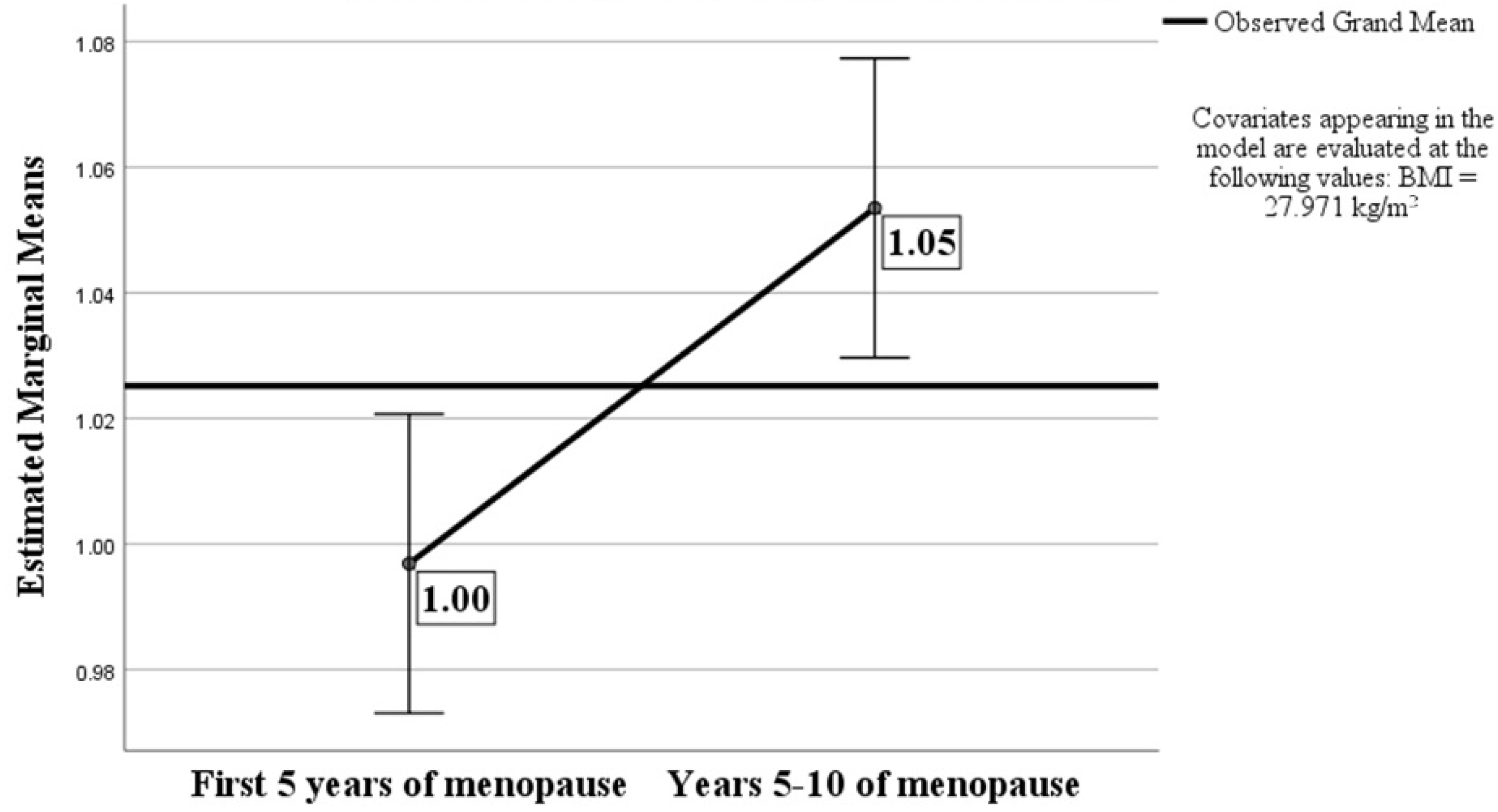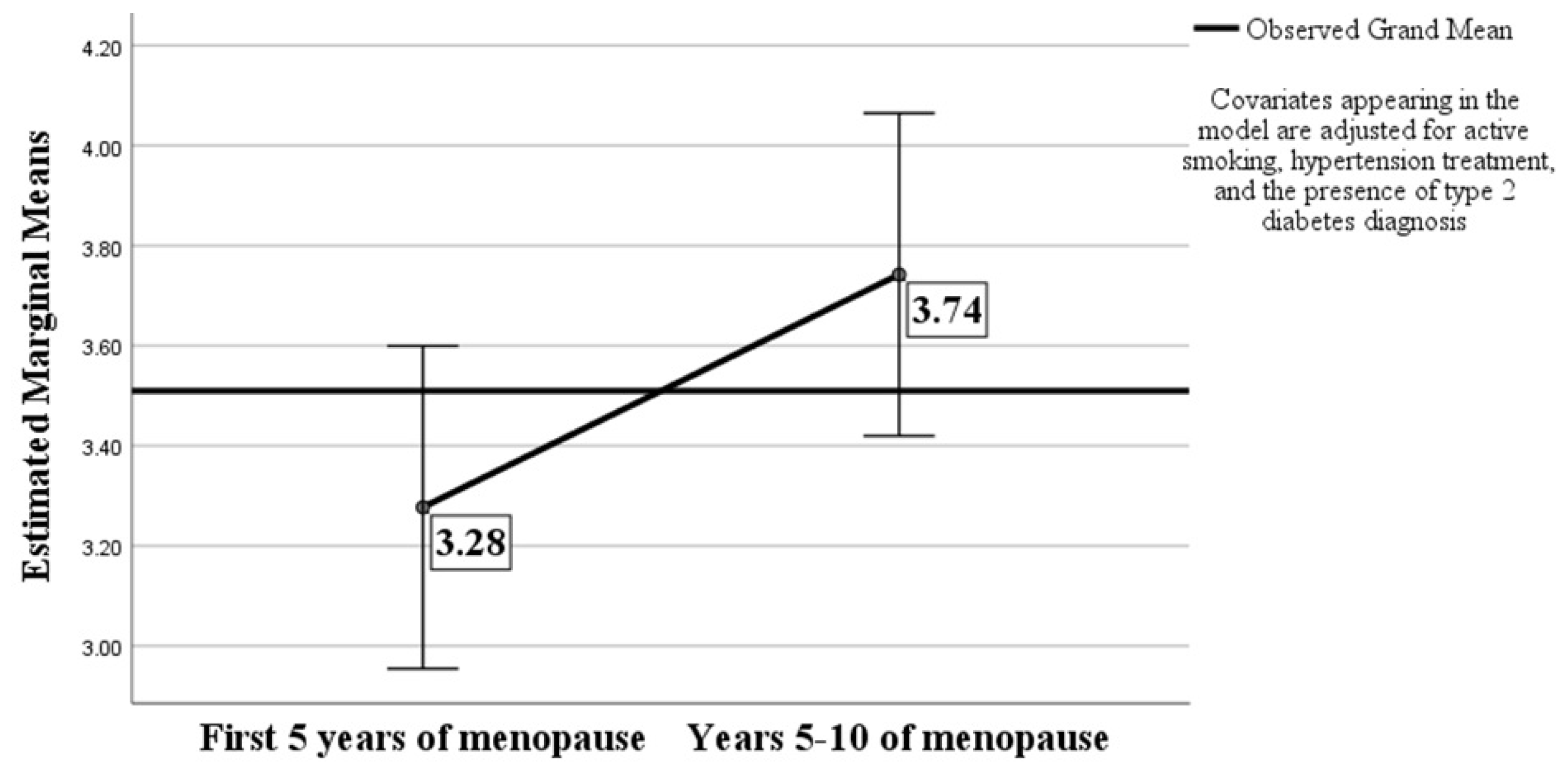DXA Android-to-Gynoid Ratio and Cardiovascular Risk Assessment in Age and BMI Propensity-Matched Early Postmenopausal Women
Abstract
1. Introduction
2. Materials and Methods
3. Results
4. Discussion
5. Conclusions
Author Contributions
Funding
Institutional Review Board Statement
Informed Consent Statement
Data Availability Statement
Acknowledgments
Conflicts of Interest
Abbreviations
References
- Weir, C.B.; Jan, A. BMI Classification Percentile and Cut Off Points. In StatPearls; StatPearls Publishing: Treasure Island, FL, USA, 2023. [Google Scholar]
- Fenton, A. Weight, Shape, and Body Composition Changes at Menopause. J. Midlife Health 2021, 12, 187–192. [Google Scholar] [CrossRef] [PubMed]
- Ambikairajah, A.; Walsh, E.; Tabatabaei-Jafari, H.; Cherbuin, N. Fat mass changes during menopause: A metaanalysis. Am. J. Obstet. Gynecol. 2019, 221, 393–409.e50. [Google Scholar] [CrossRef]
- Karvonen-Gutierrez, C.; Kim, C. Association of Mid-Life Changes in Body Size, Body Composition and Obesity Status with the Menopausal Transition. Healthcare 2016, 4, 42. [Google Scholar] [CrossRef] [PubMed]
- Kuriyan, R. Body composition techniques. Indian J. Med. Res. 2018, 148, 648–658. [Google Scholar] [CrossRef] [PubMed]
- Shepherd, J.A.; Ng, B.K.; Sommer, M.J.; Heymsfield, S.B. Body composition by DXA. Bone 2017, 104, 101–105. [Google Scholar] [CrossRef] [PubMed]
- Lee, B.J.; Yim, M.H. Comparison of anthropometric and body composition indices in the identification of metabolic risk factors. Sci. Rep. 2021, 11, 9931. [Google Scholar] [CrossRef] [PubMed]
- Goldstein, S.R.; Hirsch, J.; Oh, C.; Nachtigall, L. DXA assessment of adiposity is a better predictor of metabolic risk than BMI. In The North American Menopause Society Annual Meeting; Poster P-80; Lippincott Williams & Wilkins: Las Vegas, NV, USA, 2015. [Google Scholar]
- Blouin, K.; Boivin, A.; Tchernof, A. Androgens and body fat distribution. J. Steroid Biochem. Mol. Biol. 2008, 108, 272–280. [Google Scholar] [CrossRef] [PubMed]
- Peppa, M.; Koliaki, C.; Hadjidakis, D.I.; Garoflos, E.; Papaefstathiou, A.; Katsilambros, N.; Raptis, S.A.; Dimitriadis, G.D. Regional fat distribution and cardiometabolic risk in healthy postmenopausal women. Eur. J. Intern. Med. 2013, 24, 824–831. [Google Scholar] [CrossRef]
- Okosun, I.S.; Seale, J.P.; Lyn, R. Commingling effect of gynoid and android fat patterns on cardiometabolic dysregulation in normal weight American adults. Nutr. Diabetes 2015, 5, e155. [Google Scholar] [CrossRef]
- Dehghan, A.; Vasan, S.K.; Fielding, B.A.; Karpe, F. A prospective study of the relationships between change in body composition and cardiovascular risk factors across the menopause. Menopause 2021, 28, 400–406. [Google Scholar] [CrossRef]
- Ward, L.C. Bioelectricasl impedance analysis for body composition assessment: Reflections on accuracy, clinical utility, and standardization. Eur. J. Clin. Nutr. 2019, 73, 194–199. [Google Scholar] [CrossRef] [PubMed]
- Czartoryski, P.; Garcia, J.; Manimaleth, R.; Napolitano, P.; Watters, H.; Weber, C.; Alvarez-Beaton, A.; Nieto, A.C.; Patel, A.; Peacock, C.; et al. Body composition assessment: A comparison of the DXA, InBody 270, and Omron. JEN 2020, 3, 1–6. [Google Scholar]
- Zhu, D.; Chung, H.F.; Pandeya, N.; Dobson, A.J.; Kuh, D.; Crawford, S.L.; Gold, E.B.; Avis, N.E.; Giles, G.G.; Bruinsma, F.; et al. Body mass index and age at natural menopause: An international pooled analysis of 11 propective studies. Eur. J. Epidemiol. 2018, 33, 699–710. [Google Scholar] [CrossRef] [PubMed]
- Erdélyi, A.; Pálfi, E.; Tűű, L.; Nas, K.; Szűcs, Z.; Török, M.; Jakab, A.; Várbíró, S. The importance of nutrition in menopause and perimenopause–a review. Nutrients 2023, 16, 27. [Google Scholar] [CrossRef] [PubMed]
- Trémollieres, F.A.; Pouilles, J.M.; Ribot, C.A. Relative influence of age and menopause on total and regional body composition changes in postmenopausal women. Am. J. Obstet. Gynecol. 1996, 175, 1594–1600. [Google Scholar] [CrossRef] [PubMed]
- Toth, M.J.; Tchernof, A.; Sites, C.K.; Poehlman, E.T. Menopause-related changes in body fat distribution. Ann. N. Y. Acad. Sci. 2000, 904, 502–506. [Google Scholar] [CrossRef]
- Douchi, T.; Yamamoto, S.; Yoshimitsu, N.; Andoh, T.; Matsuo, T.; Nagata, Y. Relative contribution of aging and menopause to changes in lean and fat mass in segmental regions. Maturitas 2002, 42, 301–306. [Google Scholar] [CrossRef]
- Goff, D.C.; Lloyd-Jones, D.M.; Bennett, G.; Coady, S.; D’Agostino, R.B.; Gibbons, R.; Greenland, P.; Lackland, D.T.; Levy, D.; O’Donnell, C.J.; et al. 2013 ACC/AHA guideline on the assessment of cardiovascular risk: A report of the American College of Cardiology/American Heart Association Task Force on Practice Guidelines. Circulation 2014, 129 (Suppl. S2), S49–S73, Erratum in Circulation. 2014, 129 (Suppl. S2), S74–S75. [Google Scholar] [CrossRef] [PubMed]
- Bibbins-Domingo, K.; Grossman, D.C.; Curry, S.J.; Davidson, K.W.; Epling, J.W.; García, F.A.; Gillman, M.W.; Kemper, A.R.; Krist, A.H.; Kurth, A.E.; et al. Statin Use for the Primary Prevention of Cardiovascular Disease in Adults: US Preventive Services Task Force Recommendation Statement [published correction appears in JAMA. JAMA 2016, 316, 1997–2007, Erratum in JAMA 2020, 323, 669–670. [Google Scholar] [CrossRef]
- ASCVD 2013 Risk Calculator from AHA/ACC. 2013. Available online: https://www.mdcalc.com/calc/3398/ascvd-atherosclerotic-cardiovascular-disease-2013-risk-calculator-aha-acc (accessed on 7 May 2024).
- Palacios, S.; Henderson, V.W.; Siseles, N.; Tan, D.; Villaseca, P. Age of menopause and impact of climacteric symptoms by geographical region. Climacteric 2010, 13, 419–428. [Google Scholar] [CrossRef]
- Kevenaar, M.E.; Themmen, A.P.; Rivadeneira, F.; Uitterlinden, A.G.; Laven, J.S.; van Schoor, N.M.; Lips, P.; Pols, H.A.; Visser, J.A. A polymorphism in the AMH type II receptor gene is associated with age at menopause in interaction with parity. Hum. Reprod. 2007, 22, 2382–2388. [Google Scholar] [CrossRef] [PubMed]
- Voorhuis, M.; Onland-Moret, N.C.; van der Schouw, Y.T.; Fauser, B.C.; Broekmans, F.J. Human studies on genetics of the age at natural menopause: A systematic review. Hum. Reprod. Update 2010, 16, 364–377. [Google Scholar] [CrossRef]
- Harlow, S.D.; Gass, M.; Hall, J.E.; Lobo, R.; Maki, P.; Rebar, R.W.; Sherman, S.; Sluss, P.M.; De Villiers, T.J.; STRAW+ 10 Collaborative Group. Executive summary of the Stages of Reproductive Aging Workshop +10: Addressing the unfinished agenda of staging reproductive aging. Climacteric 2012, 15, 105–114. [Google Scholar] [CrossRef]
- Dorjgochoo, T.; Kallianpur, A.; Gao, Y.T.; Cai, H.; Yang, G.; Li, H.; Zheng, W.; Shu, X.O. Dietary and lifestyle predictors of age at natural menopause and reproductive span in the Shanghai Women’s Health Study. Menopause 2008, 15, 924–933. [Google Scholar] [CrossRef]
- Schoenaker, D.A.; Jackson, C.A.; Rowlands, J.V.; Mishra, G.D. Socioeconomic position, lifestyle factors and age at natural menopause: A systematic review and meta-analyses of studies across six continents. Int. J. Epidemiol. 2014, 43, 1542–1562. [Google Scholar] [CrossRef] [PubMed]
- Leidy, L.E. Timing of menopause in relation to body size and weight change. Hum. Biol. 1996, 68, 967–982. [Google Scholar] [PubMed]
- Ciubean, A.D.; Ungur, R.A.; Irsay, L.; Ciortea, V.M.; Borda, I.M.; Onac, I.; Vesa, S.C.; Buzoianu, A.D. Health-related quality of life in Romanian postmenopausal women with osteoporosis and fragility fractures. Clin. Interv. Aging 2018, 13, 2465–2472. [Google Scholar] [CrossRef]
- Salpeter, S.R.; Walsh, J.M.; Ormiston, T.M.; Greyber, E.; Buckley, N.S.; Salpeter, E.E. Meta-analysis: Effect of hormone-replacement therapy on components of the metabolic syndrome in postmenopausal women. Diabetes Obes. Metab. 2006, 8, 538–554. [Google Scholar] [CrossRef]
- Bednarek-Tupikowska, G.; Filus, A.; Kuliczkowska-Płaksej, J.; Tupikowski, K.; Bohdanowicz-Pawlak, A.; Milewicz, A. Serum leptin concentrations in pre- and postmenopausal women on sex hormone therapy. Gynecol. Endocrinol. 2006, 22, 207–212. [Google Scholar] [CrossRef]
- Bell, R.J.; Davison, S.L.; Papalia, M.A.; McKenzie, D.P.; Davis, S.R. Endogenous androgen levels and cardiovascular risk profile in women across the adult life span. Menopause 2007, 14, 630–638. [Google Scholar] [CrossRef]
- Greendale, G.A.; Sternfeld, B.; Huang, M.; Han, W.; Karvonen-Gutierrez, C.; Ruppert, K.; Cauley, J.A.; Finkelstein, J.S.; Jiang, S.F.; Karlamangla, A.S. Changes in body composition and weight during the menopause transition. JCI Insight 2019, 4, e124865. [Google Scholar] [CrossRef] [PubMed]
- Cao, Y.; Zhang, S.; Zou, S.; Xia, X. The relationship between endogenous androgens and body fat distribution in early and late postmenopausal women. PLoS ONE 2013, 8, e58448, Erratum in PLoS ONE 2013, 8. [Google Scholar] [CrossRef] [PubMed]
- Kapoor, E.; Collazo-Clavell, M.L.; Faubion, S.S. Weight Gain in Women at Midlife: A Concise Review of the Pathophysiology and Strategies for Management. Mayo Clin. Proc. 2017, 92, 1552–1558. [Google Scholar] [CrossRef] [PubMed]
- Stamatelopoulos, K.; Apostolakis, M.; Augoulea, A.; Paschou, S.A.; Armeni, E.; Panoulis, K.; Bakas, P.; Georgiopoulos, G.; Kaparos, G.; Rizos, D.; et al. Predictors of incident hypertension in healthy non-diabetic postmenopausal women with normal renal function. Gynecol. Endocrinol. 2019, 35, 1063–1066. [Google Scholar] [CrossRef]
- Wietlisbach, V.; Marques-Vidal, P.; Kuulasmaa, K.; Karvanen, J.; Paccaud, F.; WHO MONICA Project. The relation of body mass index and abdominal adiposity with dyslipidemia in 27 general populations of the WHO MONICA Project. Nutr. Metab. Cardiovasc. Dis. 2013, 23, 432–442. [Google Scholar] [CrossRef] [PubMed]
- Ma, W.; Zhu, H.; Yu, X.; Zhai, X.; Li, S.; Huang, N.; Liu, K.; Shirai, K.; Sheerah, H.A.; Cao, J. Association between android fat mass, gynoid fat mass and cardiovascular and all-cause mortality in adults: NHANES 2003-2007. Front. Cardiovasc. Med. 2023, 10, 1055223. [Google Scholar] [CrossRef] [PubMed]
- Aggarwal, B.; Scaccia, S.; Davis, E.; Kodoth, V.; Liu, S.; Wummer, B.; Sun, Y. Associations Between Body Composition, Diet, And CVD Risk Markers Among Women During The Menopausal Transition: Findings From The AHA Research Goes Red Women’s Health Registry. Circulation 2022, 145 (Suppl. S1), AP061. [Google Scholar] [CrossRef]


| First 5 Years of MP (N = 90) | Years 5–10 of MP (N = 90) | Sig | |
|---|---|---|---|
| Age | 53.53 ± 2.56 | 53.44 ± 2.48 | 0.811 |
| Age at FMP | 50.06 ± 2.63 | 46.07 ± 2.86 | <0.001 |
| Years of Estrogen Exposure | 37 (3) | 32.5 (4) | <0.001 |
| Years of MP | 3.55 (1.8) | 7.15 (2.7) | <0.001 |
| BMI (kg/m2) | 27.79 ± 4.12 | 28.03 ± 3.83 | 0.692 |
| Total Body Fat % | 45.9 (6.4) | 47.25 (7.2) | 0.086 |
| Android Fat % | 47.8 (10.6) | 50 (7.4) | 0.180 |
| Gynoid Fat % | 46.5 (4.8) | 47.3 (6.3) | 0.371 |
| A/G Ratio | 0.99 ± 0.13 | 1.05 ± 0.11 | 0.001 |
| First 5 Years of MP (N = 90) | Years 5–10 of MP (N = 90) | Sig | |
|---|---|---|---|
| HTN treatment (%) | 30/90 (33.3%) | 31/90 (35.5%) | 1.000 |
| Diagnosis of T2DM (%) | 8/90 (8.9%) | 6/90 (6.7%) | 0.650 |
| Statin treatment (%) | 24/90 (26.7%) | 20/90 (22.2%) | 0.603 |
| Serum total cholesterol (mg/dL) | 207 (54) | 226 (62) | 0.019 |
| Serum HDL cholesterol (mg/dL) | 57 (17) | 54.5 (15.25) | 0.527 |
| Serum LDL cholesterol (mg/dL) | 131.6 (46.8) | 140.4 (55.1) | 0.132 |
| Serum triglycerides (mg/dL) | 87 (58) | 97 (59.25) | 0.214 |
| 10-year ASCVD risk (%) | 2.95 (2.5) | 2.7 (2.41) | 0.340 |
| HTN treatment (%) | 30/90 (33.3%) | 31/90 (35.5%) | 1.000 |
Disclaimer/Publisher’s Note: The statements, opinions and data contained in all publications are solely those of the individual author(s) and contributor(s) and not of MDPI and/or the editor(s). MDPI and/or the editor(s) disclaim responsibility for any injury to people or property resulting from any ideas, methods, instructions or products referred to in the content. |
© 2024 by the authors. Licensee MDPI, Basel, Switzerland. This article is an open access article distributed under the terms and conditions of the Creative Commons Attribution (CC BY) license (https://creativecommons.org/licenses/by/4.0/).
Share and Cite
Nistor, I.M.; Fica, S.; Martin, S.C.; Mustata, T.; Oprea, T.E.; Sirbu, A.E.; Barbu, C.G. DXA Android-to-Gynoid Ratio and Cardiovascular Risk Assessment in Age and BMI Propensity-Matched Early Postmenopausal Women. Medicina 2024, 60, 1096. https://doi.org/10.3390/medicina60071096
Nistor IM, Fica S, Martin SC, Mustata T, Oprea TE, Sirbu AE, Barbu CG. DXA Android-to-Gynoid Ratio and Cardiovascular Risk Assessment in Age and BMI Propensity-Matched Early Postmenopausal Women. Medicina. 2024; 60(7):1096. https://doi.org/10.3390/medicina60071096
Chicago/Turabian StyleNistor, Irina Manuela, Simona Fica, Sorina Carmen Martin, Theodor Mustata, Theodor Eugen Oprea, Anca Elena Sirbu, and Carmen Gabriela Barbu. 2024. "DXA Android-to-Gynoid Ratio and Cardiovascular Risk Assessment in Age and BMI Propensity-Matched Early Postmenopausal Women" Medicina 60, no. 7: 1096. https://doi.org/10.3390/medicina60071096
APA StyleNistor, I. M., Fica, S., Martin, S. C., Mustata, T., Oprea, T. E., Sirbu, A. E., & Barbu, C. G. (2024). DXA Android-to-Gynoid Ratio and Cardiovascular Risk Assessment in Age and BMI Propensity-Matched Early Postmenopausal Women. Medicina, 60(7), 1096. https://doi.org/10.3390/medicina60071096







